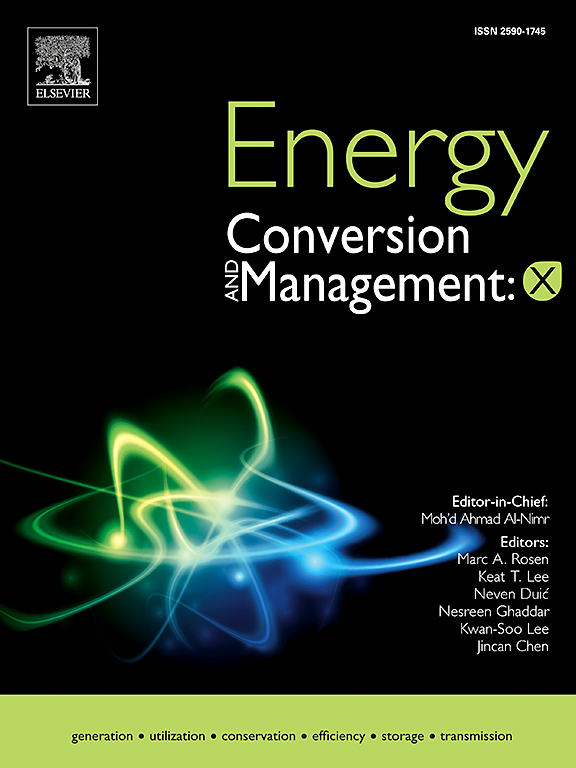The cost of green: Analyzing the economic feasibility of hydrogen production from offshore wind power
IF 7.1
Q1 ENERGY & FUELS
引用次数: 0
Abstract
Wind energy is a cornerstone for enhancing grid stability and augmenting energy storage solutions, especially through its synergy with green hydrogen production. While substantial research has analyzed the economic dynamics of offshore wind and green hydrogen, the impact of offshore distances on hydrogen production costs remains underexplored. This study introduces a novel, globally applicable modeling framework for the Levelized Cost of Hydrogen (LCOH), illustrated using the strategically significant Taiwan Strait as a case study. By employing net present value analysis, we compare centralized, distributed, and onshore hydrogen production scenarios, documenting the lowest current LCOH values at $10.27, $10.31, and $11.32 per kg of hydrogen respectively. These findings highlight the cost-effectiveness of the centralized configuration and emphasize the significant costs linked to transmission infrastructure in onshore setups. Looking ahead to 2035, our framework predicts substantial reductions in LCOH, with low-cost scenarios forecasting profitability at just $9 per kilogram of hydrogen. Powered by the universally accessible ERA5 reanalysis dataset, our approach supports analogous assessments worldwide, thereby aiding strategic planning and the deployment of renewable technologies. In-depth sensitivity and Monte Carlo analyses further enhance our understanding of the impacts of offshore distance and other key factors, bolstering the economic evaluation of green hydrogen production. This comprehensive methodology not only assesses present capabilities but also facilitates broad application, fostering the strategic development of renewable technologies globally.
绿色成本:分析利用海上风能制氢的经济可行性
风能是提高电网稳定性和增强储能解决方案的基石,特别是通过其与绿色制氢的协同作用。虽然已有大量研究分析了海上风能和绿色制氢的经济动态,但离岸距离对制氢成本的影响仍未得到充分探索。本研究介绍了一种新颖的、全球适用的氢气平准化成本(LCOH)建模框架,并以具有重要战略意义的台湾海峡为案例进行了说明。通过采用净现值分析,我们对集中式、分布式和陆上制氢方案进行了比较,结果表明目前的最低 LCOH 值分别为每公斤氢 10.27 美元、10.31 美元和 11.32 美元。这些发现凸显了集中式配置的成本效益,并强调了陆上配置中与传输基础设施相关的巨大成本。展望 2035 年,我们的框架预测 LCOH 将大幅降低,低成本方案预测每公斤氢气的盈利能力仅为 9 美元。我们的方法以普遍可用的ERA5再分析数据集为基础,支持全球范围内的类似评估,从而有助于战略规划和可再生技术的部署。深入的敏感性和蒙特卡洛分析进一步加深了我们对离岸距离和其他关键因素影响的理解,加强了绿色制氢的经济评估。这种全面的方法不仅能评估目前的能力,还能促进广泛应用,推动全球可再生技术的战略发展。
本文章由计算机程序翻译,如有差异,请以英文原文为准。
求助全文
约1分钟内获得全文
求助全文
来源期刊

Energy Conversion and Management-X
Multiple-
CiteScore
8.80
自引率
3.20%
发文量
180
审稿时长
58 days
期刊介绍:
Energy Conversion and Management: X is the open access extension of the reputable journal Energy Conversion and Management, serving as a platform for interdisciplinary research on a wide array of critical energy subjects. The journal is dedicated to publishing original contributions and in-depth technical review articles that present groundbreaking research on topics spanning energy generation, utilization, conversion, storage, transmission, conservation, management, and sustainability.
The scope of Energy Conversion and Management: X encompasses various forms of energy, including mechanical, thermal, nuclear, chemical, electromagnetic, magnetic, and electric energy. It addresses all known energy resources, highlighting both conventional sources like fossil fuels and nuclear power, as well as renewable resources such as solar, biomass, hydro, wind, geothermal, and ocean energy.
 求助内容:
求助内容: 应助结果提醒方式:
应助结果提醒方式:


